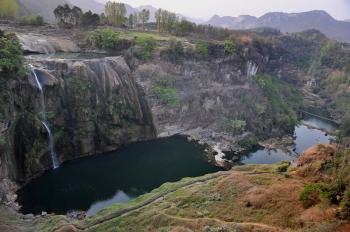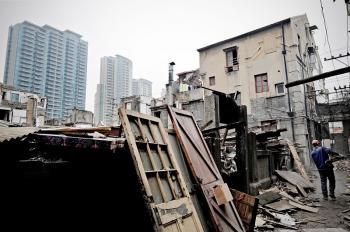Among the seven major rivers in China, the Yangtze and Pearl Rivers have always been considered less polluted, when compared to other rivers such as the Haihe River, the Liaohe River, Yellow River, Huaihe River, and the Songhua River. However, with industrial and economic development in the deltas of the Yangtze and Pearl Rivers, industrial waste is compromising water quality. Recently, the Yangtze River Water Conservancy Committee published a report which stated that 28.8 billion tons of waste water was discharged into the Yangtze River in 2004. The water quality of the Yangtze River is worsening. Environmental protection experts warn that if the authorities don’t take immediate action to protect the Yangtze, it will become another “Yellow River” in ten years.
The Yangtze River basin covers approximately 1.8 million square kilometers (70,000 square miles) in 19 provinces in China. It encompasses more than 33 percent of the nation’s population, produces 33 percent of the nation’s food, creates 33 percent of China’s GDP, and provides 36.5 percent of China’s water resources.
The Yangtze River Water Conservancy Committee recently published “A Report on the Water of the Yangtze River Tributary System.” According to the study, the Yangtze River Bureau rated 72.5 percent of the Yangtze River system [37,447 kilometers long (23,404 miles)] with a water quality index of 1, 2, and 3, with 3 representing a better water quality rating. The water quality below level 3 has increased from 22.5 percent last year to 27.5 percent this year. This included 7 percent in level 4, and 5 percent in level 5, with the remaining 15.5 percent characterized as below level 5. The water quality of the Yangtze River is progressively deteriorating.
Wang Weiluo, a hydrologist from China who presently lives in Germany, told The Epoch Times , “The assessment of water resources is classified into 5 levels in China. Levels 1 and 2 were classified as drinking water before. After 1990, the water quality in China progressively deteriorated, so the authorities changed the entire standard of classification. They changed level 3 up to drinking water ratings. Take the concrete pollution index COD (Chemical Oxygen Demand) as an example. Level 1 water is the same as level 3 was in 1990, which was level 5 in 1980.”
About 700 to 800 million people in China are drinking polluted water
The latest report released by the Yangtze River Water Conservancy Committee pointed out that the amount of waste water discharged into the Yangtze River was about 28.8 billion tons in 2004, which includes 30 percent domestic waste water and 70 percent industrial waste water. Compared to 1999, the amount of waste water in the Yangtze River has increased 40 percent. In 1970, the waste water drainage into the Yangtze River was only 9.5 billion tons, and in 1980 it was 15 billion tons.
The waste water in the Yangtze River is mainly from regions that have been experiencing rapid developing economies. According to official media, an important factor of the pollution in the Yangtze River is the large and medium cities along the river, such as Shanghai, Nanjing, Wuhan, Chongqing, etc., which worsen the pollution. Only 50 percent of waste water is treated in major cities along the Yangtze River. It is even lower in medium and small cities.
With the rapid increase of the waste water discharged into the Yangtze River, the sources of drinking water in more than 500 cities along the Yangtze River are adversely affected.
According to the investigation by the environmental departments for the seven major rivers in China, the pollution levels from the most serious to the least are the Haihe River, Liaohe River, Yellow River, Huaihe River, Songhua River, Yangtze River, and Pearl River. The head of the Ministry of Hydrology in China, Wang Shucheng, admitted that more than 300 million people in the rural areas of China drink unsafe water. The water is also seriously polluted in a large number of cities, which has threatened people’s health and lives.
Wang Weluo pointed out that the figure quoted by the Hydrology Minister is not accurate. Actually, about 700-800 million people in China are drinking polluted water. He said that the Huaihe River, Yellow River, Haihe River, and Liaohe River are seriously polluted. Now, the water quality of 28 percent of the Yangtze River is also at level 4 and 5. The quality of the drinking water in these areas is not certified.
Long-term pumping of ground water has almost exhausted sources in northern China
Because water pollution has worsened, due to economic development, China’s water crisis becomes more serious by the day. According to official sources, about 400 of 669 Chinese cities have a water shortage. One hundred ten of these cities have a severe shortage. Nationwide, there is a 6 billion cubic meter (1,585 billion gallon) shortage of water.
People in China have turned to ground water when there is not enough surface water or because the surface water has been polluted. In many areas in northern China, excessive use of ground water has almost exhausted supplies. Because of the long-term and excessive pumping of ground water, half of the urban districts in mainland China at present have serious ground water pollution and other environmental consequences, such as land settling.
According to an evaluation taken in October 2003 of China’s ground water sources, excessive pumping of ground water has caused land settling covering a total area of 37 million acres and has formed over 100 sinkholes. On the northern plains of the Haihe River, there is a single settling area of 17 million acres, the largest in the nation. On the south side of the Yangtze River delta, pumping has also caused the ground to settle and formed open fissures in some areas. The settling has caused an economic loss in the Yangtze delta area of nearly 350 billion yuan (US$43 billion).
Pollution causes water shortages in southern China, preventing economic development
In northern China, there are severe water shortages. However in areas of southern China, they have water, but aren’t able to use it. Neglecting to treat sewage water before releasing it into the rivers has polluted their water sources. This phenomenon is more obvious in areas of high economic development such as Jiangsu, Zhejiang, and Guangdong provinces.
For example: In Zhejiang province, there is a serious shortage of water in Ningpo city, at an intersection of the Yong River, Yao River, and Fenghua River, at Zhoushan city. In the urban district of Yiwu City, an international trade city, there are occasions when only 9 hours of running water is available during a week. Yiwu’s water use for an average person is only 25 percent of the national average.
In recent years, Guangdong province, which is an area with plentiful rain and water supplied by the Pearl River which passes through it, has even been facing a problem of water shortages! The Bureau of Geological Prospecting and Surveying of Guangdong Province predicted that by 2010, Guangdong will have a shortage of 2,181 billion gallons of water. Starting from the 1980s with the rapid economic development in Guangdong, water pollution became more serious by the day. The rivers that pass through cities have nearly all been polluted. Many rivers are already untreatable.
Pearl River Water Conservancy Committee official Yue Zhongming, once pointed out that uncontrolled economic development is the reason for the Pearl River’s pollution. Large amounts of pollutants being discharged into the river surpassed the river’s natural ability to purify itself. The severe lack of water near the Yangtze and Pearl River deltas will pose a challenge to continuing economic development.
Water crisis challenges the nation’s survival
Water conservation expert Wang Weiluo believes that the reason for the rapid worsening of water quality in China is the Chinese Communist Party’s policy towards economic development: economic development and making money is its most important objective. He said that the CCP’s model for economic development is “money, not lives.” It sacrifices the living environment for all Chinese people and their descendents, just to maintain their so-called accelerated economic growth.
Why can’t China’s environmental pollution be cured like it was in Western countries, instead of becoming more and more serious? Zheng Yi, the author of China’s Ecological Winter, thinks that the main reason is the system. More specifically, the property rights and obligations of the lands and natural resources are undefined, which makes them more susceptible to pollution (i.e. no one takes responsibility to protect the natural resources). He gave an example, compared to democratic countries in the West, environmental pollution is much worse in all current and former communist countries.
Zheng Yi pointed out, “Mountains, rivers, and land are the basic requirements for survival. China’s Yellow River has already dried up in some areas; it is basically dead. The Yangtze River has a bit more time left, because of its large volume of water, but it too is headed down the Yellow River’s path. The destruction of these natural resources is an enormous sin. Our descendents will live in a difficult and desperate environment.”




